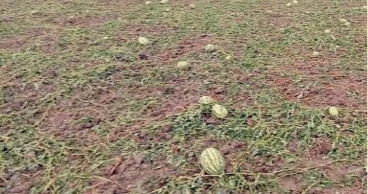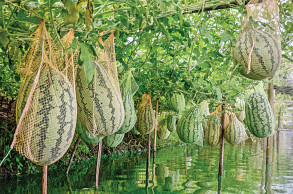watermelon
3 Chuadanga vendors fall victim to ‘Dope gang’; lose Tk 3.8 lakh
Members of a dope gang (Aggyan Party) have looted around Tk 3.8 lakh from three watermelon vendors from Chuadanga while purchasing watermelons in Patuakhali.
The victims are Sajib Ali, 30, Mominur Rahman Molla, 65, and Milan Mechanic, 40, hailing from Chuadanga Sadar upazila.
According to the victims, they boarded a bus from Dingedah Bazar heading toward Shakharia Bazar in Patuakhali to purchase watermelons from Mashuri Ghat on Friday.
Along the way, they met a man who later accompanied them to a residential hotel in Patuakhali for rest and Iftar.
The man arranged Iftar including a special drink and shortly after drinking it they lost consciousness, he said.
Member of ‘dope gang’ arrested at Dhaka airport
Upon regaining consciousness, one of them found their money and belongings missing.
Later, another vendor from the Dingedah came to know about the vendors in Patuakhali and arranged for their return to Chuadanga by bus.
They arrived at Dingedah Bazar around 4pm on Saturday after which family members took Mominur and Milan home.
However, due to his deteriorating condition, Sajib was taken to Chuadanga Sadar Hospital where physician Dr. Sajib Hossain admitted him for observation.
300 people robbed in 15 years by dope gang in Dhaka airport area
The physician said the patient was brought unconscious and provided initial treatment before admitting him for observation.
It appears they were given sedatives mixed in their food or drinks and it may take Sajib 24 to 48 hours for full recovery, he said.
9 months ago
Off-season watermelons making Narail farmers smile
Farmers in Narail district are seeing profits multiplied up to six times by growing off-season watermelons in Kalia upazila, thanks to the local agricultural department officials for introducing hybrid variants of watermelons in the area.
Normally, February to April is the season of the mouth-watering summer fruit but officials of the local Department of Agriculture Extension (DAE) introduced hybrid variants in Kalia upazila during monsoon.
A total of eight hectares of land in Kalia upazila are being used to grow the off-season watermelons, with a target to produce 15 tonnes of the fruit per hectare. The DAE officials provided fertilizers, seeds and cash to the farmers and with their help, watermelons are being cultivated along the bank of the fish enclosures and waterbodies in Gobindanagar, Salamabad, and Bhaktadanga areas.
On a remote char in country's poorest district, watermelon cultivation transforms lives
Farmers are growing Asian-2, Tripti and Black Baby hybrid variants of watermelon. These variants taste sweet and delicious, they say.
Farmers say they spent Tk 15,000-20,000 per hectare and sold watermelons worth Tk 1.5 lakh to 2 lakh per hectare.
Sheikh Kamal Hossain, a resident of Bhaurir Char in the upazila and assistant professor at Nabadanga Degree College, said, “I took training from Dumuria upazila of Khulna district and after that, I have planted 1000 saplings of watermelon on seven acres of land along the fish enclosures on an experimental basis last year. I have earned Tk 2 lakh from this.”
This year, he planted 2000 saplings on the same land after spending Tk 70,000. He expects to earn Tk 4 lakh from watermelon production this year.
Rain, hailstorm worry Khulna watermelon growers
Pradeep Kumar Barman, councilor of ward-6 under Kalia municipality, said this year he planted 12,000 saplings along the bank of 150 bigha of fish enclosures during monsoon. “So far I have spent Tk 10 lakh. Within 35 days, flowers started to bloom and I started harvesting watermelon within 60-65 days of planting. Each watermelon weighs almost 4 kg.”
He also expected to produce 2 lakh kgs of watermelon this year and if the market prices remain favorable, he could be able to earn Tk 40 lakh.
Low price dims the joy of watermelon growers in Khulna despite bumper harvest
Depak Kumar Roy, deputy director of Narail DAE, said the farmers are earning profits up to six times considering their expenditure, within 60-65 days of cultivation. “We are providing all-out support through using smart technology and providing fertilizer and pesticides for good production of watermelon.”
Eva Mallik, Kalia Upazila Agriculture Officer, said “Watermelon is no longer a seasonal fruit now, and it can be produced throughout the year. Flowers start to bloom within 40-50 days of planting saplings and 70-80 days are needed for harvesting.”
Most of the farmers in the district are showing interest in cultivating the off-season hybrid watermelon on their lands as it has proven to be profitable, he said.
Read more: Bangladesh can go for Chinese perennial rice farming to reduce cost and labour
2 years ago
On a remote char in country's poorest district, watermelon cultivation transforms lives
Watermelon cultivation has started in the remote char area of the Brahmaputra River in Kurigram.
Although watermelon cultivation started on an experimental basis last year, the number of farmers signing up to the this time. The yield has also been as expected. Farmers are hoping for double the profit if there is no flood in advance this year.
However, if the government comes forward in marketing and banks provide loans with easy instalments, the misery of the people of the char area can be erased, or at least eased.
Also read: Rain, hailstorm worry Khulna watermelon growers
According to the Kurigram Department of Agricultural Extension, there are about 450 chars in 16 rivers in the district. There are about 45,000 hectares of cultivable land. Of these, farmers are starting cultivation on 35,000 hectares of land in 368 chars. Maize, watermelon, sweet pumpkin, cucumber and pepper have been cultivated in these char areas.
Last year, watermelon was cultivated on 50 acres of land in Char Bagua village of Hatia union of Ulipur upazila of the district. In the early floods, 40 acres of crops were submerged and damaged. Yet the farmers did not stop. This year watermelon has been cultivated on 34 hectares of land in the char.
Farmers have also started harvesting watermelons. Due to favorable weather conditions, the yield has also been as expected. As a result, they are hoping to make a good profit this time after overcoming last year's loss. However, the biggest obstacle to commercial cultivation in the char is marketing management. Besides, many farmers have left the land after being unable to cultivate these crops despite the desire, the banks not providing loans to the common farmers.
Read More: Floating vegetable farmers in Pirojpur devastated by low prices
Dashim Uddin of Bagua Char said three enterprising farmers have cultivated watermelon on 40 acres of land in this char. As a result of getting a large amount of loan from the bank, they have got the opportunity to cultivate on a large scale. Many farmers here have become interested in their farming, but they are not able to come forward due to economic reasons.
Abdur Sabur, who cultivated watermelon, said, “Although watermelon was cultivated on an experimental basis last year, the watermelon field was washed away in the early floods. This year, I have cultivated watermelon on 14 acres of land. It cost me Tk6-7 lakh. I hope to pick up 20,000 watermelons. This will earn me an additional income of Tk6-7 lakh. However, the problem here is marketing watermelon. Wholesalers come here and buy watermelons at a lower price. If we could take melons to the city and sell, we would have made more profits. More farmers would have come forward to cultivate watermelon.”
Read More: Bagerhat fruit farmer eyes foreign markets to expand thriving business
The farmer also said watermelon seeds should be sown at the beginning of the month of Paush. After four months, watermelon can be lifted in the middle of chaitra month. There are some precautions to be taken in watermelon cultivation. In the sand land, a hole of one and a half feet in the 10-inch by 10-inch square has to be given some loamy soil, dung fertilizer and DSP in the pit. Forty grams should be given in each pit. In this way, after keeping it for a week, three seeds are sown in a pit. In addition, regularly insecticides have to be sprayed to protect against the attack of insects and rats.
Abul Hossain Master, former chairman of Hatia Union, said at present, local entrepreneurs in the char area have become interested in cultivating various agricultural products. Due to economic problems, the rest of the farmers are unable to come forward. “Their misery would go away if banks and NGOs come forward.”
Additional Deputy Director (Crops) of Kurigram DAE, Md Azizul Islam, said watermelon cultivation has started in the district since last year. Watermelon has been cultivated on 22,000 hectares of land this year. There is a plan to set up a collection center in the char areas so that the farmers do not suffer for marketing.
Read More: Exporters want green signal for commercial cultivation of King Prawn
2 years ago
Rain, hailstorm worry Khulna watermelon growers
Despite bumper yield of watermelon in Khulna this year, farmers and traders fear massive losses due to hailstorm, heavy rains and fall in price.
On March 21, hailstorm damaged huge amount of watermelon on around 203 hectares of land worth about Tk 10 crore.
According to officials of the Department of Agricultural Extension (DAE), in 2016 watermelon was cultivated only on 407 hectares of land in Khulna. In 2021, 7,512 hectares of land was brought under cultivation and in 2022, record 13,970 hectares of land was cultivated.
Although watermelon yield was very goods last year, farmers incurred big losses due to rains and drop in price.
DAE officials said watermelon cultivation has decreased this year due to huge losses last year. This year, this summer fruit was cultivated on 12, 225 hectares of land which is 1,745 hectares less than last year’s cultivation.
Read more: Can one earn a living by farming off-season watermelon?
Local farmers and the department expected 35-40 maund yield per hectare and selling of watermelon worth Tk 611 crore. But hailstorms and continuous rain have become cause of worry.
A big portion of watermelon in Khulna is cultivated in Dacope upazila. This year, this fruit has been cultivated in a total nine unions of Dacope upazila .Local farmers have cultivated watermelon on around 6,320 hectares of land and farmers hope they will be able to start selling of the fruit by 10 to 15 days.
Watermelon has been cultivated on 1,200 hectares of land in Koyra Upazila this year and the crops will be ready for market within 15 days. In the meantime, 200 hectares of land in Koyra and 3 hectares of land in Paikgachha were completely destroyed due to a hailstorm on March 21.
Utpal Raptan, a farmer of Banishanta Union under Dacope Upazila, said, compared to last year, per bigha production cost has increased by Tk 4000 to 5000 this year.
Still, he cultivated 3 bighas of land to recover last year's losses .
Dacope Upazila Agriculture Officer KM Maksudunnabi said, watermelon cultivation declined due to last year’s losses. But this year yield is better than the previous year.
Read more: Mechanical engineer finds fortune in growing rock melons, becomes inspiration for local farmers
Mosaddek Hossain, additional deputy director of Khulna DAE, said, " Hailstorm and rain is causing anxiety among farmers. Still, it is expected that watermelons worth 600 crores will be sold this year.”
2 years ago
Delicious Watermelon Ice Cream and Cake Recipes to Try at Home
Summer days are exhausting. During the summer season, the weather often becomes hot and humid resulting in inconvenience and dehydration. So, make sure your system stays hydrated during the summer. Eating summer fruits is the best way to do the same. Among summer fruits, watermelon can be your perfect choice to boost energy and reduce tiredness and fatigue. You can prepare tasty and healthy ice cream as well as cake recipes with watermelon. Check out some easy-to-prepare, yummy Watermelon cake and ice-cream recipes to try at home.
Is Watermelon Healthy?
Yes! Watermelon has huge health benefits. Summers become incomplete without watermelon. It is red, juicy, and one of the excellent fruits to fill you during the summer season. It is healthy and cheap and a great source of water, vitamin A and C as well.
Vitamin A is good for the eyes and also boosts immunity. Vitamin C boosts immunity as well. Besides, watermelon has Vitamin B6 and potassium. Potassium helps to maintain water balance in the body while Vitamin B6 improves immunity. Not only that Potassium also stops muscle cramps and keeps your heart healthy.
Read Cooking Without Oil: How and Why?
Sun causes skin damage and you prevent that by eating watermelons. Studies show that it is filled with the antioxidant lycopene which could restrain your risk of cancer and diabetes. Watermelon is great for hydration and always keeps you feeling satisfied with very few calories. To reduce inflammation and oxidative stress, you can eat sufficient watermelon.
Delectable Watermelon Ice Cream Recipe
Are you looking for a refreshing summer dessert? If yes, you must try watermelon classic ice cream at home. It is really quick, easy, and simple. It just needs 10 minutes and some simple ingredients. But it is a refreshing, flavorful, healthy treat. It helps to cool you down in an instant.
Ingredients
- 3 cups cubed watermelon
- 1 cup vanilla almond milk
- 2 tablespoons monk fruit
Read: Yummy Milkshake Ideas, Recipes to Try at Home
Instructions
- First, take a quarter sized sheet pan with parchment paper.
- Then, cut the watermelon into uniform cubes, and place it on the lined sheet pan. You need to place it in the freezer for about four hours.
- After removing watermelon from the freezer, blend it in the high-speed blender with almond milk and monk fruit.
- Make sure you blend as long as the watermelon has broken down and you have a thick, creamy consistency. If you like to enjoy it right away, serve and enjoy!
- But if you want to eat the watermelon ice cream later, you need to move it to a loaf pan. Then place it again in the freezer. But you have to remember that if you want to fill the loaf pan, you need to make two batches of ice cream.
- Finally, let it sit at room temperature for ten minutes before dipping. When it softens a bit, serve and enjoy.
Read Khichuri Recipes: 7 varieties of yummy nutritious Khichdi to try at home
3 years ago
Togur: The Molasses Made from Watermelon Juice in Bangladesh
Molasses is one of the sweetest foods in Bangladesh. And, Water Melon is one of the most popular fruits grown in Bangladesh. The juice of this succulent fruit refreshes the mind and body on summer days. But the idea of molasses made with watermelon juice is absolutely unprecedented. Mrityunjay, a watermelon farmer from Chhotobond village in Dumuria Upazila of Khulna startled the country with this wonderful innovation. He named the newly invented molasses (locally termed as ‘Gur’) 'Togur,' as it is made from watermelon (locally termed as ‘Tormuj’) juice. Let's find out some information about this new type of molasses.
How the idea of Togur came about
Mrityunjay has been cultivating watermelons since 2019. Besides good yield, he has also been able to make some profits in this period. During the cultivation season, he got some watermelons which are quite small in size. These watermelons, called 'Kats', are almost unsaleable and are left in the field. Most of the time, when they get wet in the rain, they rot and spread a bad smell. Some Kats, however, can be used as food for domestic animals and fish.
Read Yummy sweets for Durga Puja: Traditional Bengali desserts to try in the great religious festival
Suddenly one day it came to Mrityunjaya’s mind that if molasses can be made out of date and palm juice, it is possible for watermelon juice as well! Immediately, he went to the Upazila Agriculture Office to consult. Then along with his wife Mitali, he tried to make molasses with a few Kat watermelons. After making it, he was surprised at the sweet taste of Togur which looks like date molasses.
4 years ago
Peasant cultures, chicken tormuz and Ammu
A week or so back I posted on Facebook that I wanted to cook chicken with ripe watermelon. It was after I had actually bought a tormuz and was planning to cook chicken. The main consumer is my daughter and dad-cooks like us work extra hard to please children, as they lack historical experience and hence confidence. That’s another matter.
Nevertheless as I waited for the chicken to unfreeze I posted asking how it would be. As a regular Facebooker I have some idea what is enjoyed by more people and which aren’t. This post I thought was a flaky sort, passing entertainment which would disappear into the digital black hole like so many others.
Not only did it not disappear, it went I suppose you could say viral, almost gathering as many comments as emojis. But the comments stood out. As I read and responded- bad habit- I realized that I wasn’t dealing with a typical response to a “silly” post/comment but probably getting a peep into the Bangali soul, the Bangladeshi heart that beats on with both pride and anxiety. Anything more?
Two other issues emerged. One was my staple favourite – deep-baked bread which to my FB friends is burnt bread or “Pora rooti.” The other part was even more interesting. Most said the pioneer of all this deviant cooking was 'Kekappa', or Keka Ferousi, the Channel I cooking show icon. She had introduced noodles to many of her traditional dishes and remains unforgiven till date.
I was very intrigued by the responses as they kept on coming for long. And I realized that a deep and insecure/iconic part of our soul had been shaken by this simple matter of an unusual recipe. But cultural history wise, what did they all mean?
Food/cooking as social icons
Food is what life sustenance is all about so it’s all consuming. Every aspect of human behavior is linked to it. It is not only about staying alive physically but socially as well. This applies to food gathering, preparation and distribution as well. Doing all this requires an entire social process in action, touching everyone.
It’s called in very simple terms the food chain and no society can survive by ignoring it. And when food choices are limited including due to supply, this is even more applicable.
A once-insecure society is now understandably deep into food culture. We didn’t produce intermediate items to be exchanged for food for a long period but basic ones which were directly consumed. Agro-societies are always about food and its iconization. If food is secure, we are safe and continue to survive. Hence disturbing the food chain including making puts entire societies into risk. So naturally we resist any change. It’s part of any peasant culture.
Until the Mughal era when Bengal’s agro-revolution began and shifting cultivation entirely disappeared from the plains, people had very little choice despite being a delta. Thus fish consuming was limited to those living near the rivers and maybe occasional fish which was indeed very difficult to obtain. Any food constrained society develops such practices. Middle Eastern societies, pastoral in nature, adopted finger licking, partly to ensure no food is wasted.
Given that scenario, food divisions are clear. Since people had little chance of having protein in Bengal – meat or fish but meat certainly- it’s usually cooked as a single item. Vegetables are cooked as a single item and often as the main item in peasant households. Putting vegetable and protein is done only when one can ensure both – festivals- or to avoid cooking a separate dish. Fried fish is a single item and not eaten with vegetables in the same platter with as it’s a standalone glorious culinary icon of ours.
Fruits, proteins and Ammu
So where do fruits come into this? Generally, fruits are finishers, eaten at the end in all cultures as desserts and peasants rarely have it. They can hardly afford to mix a desert with the already luxury protein item so putting ripe watermelons –delicious, sweet, etc- with chicken, a rarely eaten protein, would be wasteful and hence to be avoided. Anything that can be saved needs to be so adding both will be a luxury and peasants can’t afford that.
But another factor works here in a peasant economy. All such societies are based on the “dhatri” – reproducer- concept and as the settled agriculture hit Bharat, the gods and goddesses also changed status with the emergence of Durga as the prime deity. She is the fertility icon, the producer, the one who brings food to the table. And her human representation is of course the guardian of food – the Mother. Like all societies she is the preparer of food hence the guarantor of sustenance. To deviate from her worship is to risk survival.
Therefore how Ammu cooks becomes iconic /religious ritual. It’s not a matter of taste but a sense of security and the sacred. To do otherwise is to be profane and that is a sin. Ammu never used ripe watermelons in any cooking so when we are faced with that suggestion, we are shocked and hit where it matters most, our icons, our sense of security and our sacred space.
It’s not an accident that we are a mother –worshipping society where Ammu can do no wrong. And Ammu never cooked chicken this way.
More soon when we discuss Kekappa and burnt rooti, but the basic theme is the same. It’s not the ripe watermelon brother Bangus, it’s about your Ammu.
4 years ago
Can one earn a living by farming off-season watermelon?
Khulna, Oct 15 (UNB) – Ahad Ali Sheikh of Dumuria is actually a shrimp farmer by profession. Farming shrimp on 2.5 acres of land taken on lease in Nolghona Beel, he somehow managed to earn his livelihood.
6 years ago






.jpg)





